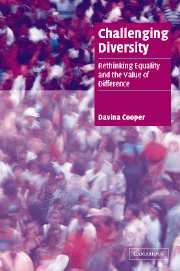Book contents
- Frontmatter
- Contents
- Acknowledgments
- 1 Introduction: mapping the terrain
- 2 Diversity politics: beyond a pluralism without limits
- 3 From blokes to smokes: theorising the difference
- 4 Towards equality of power
- 5 Normative encounters: the politics of same-sex spousal equality
- 6 Getting in the way: the social power of nuisance
- 7 Oppositional routines: the problem of embedding change
- 8 Safeguarding community pathways: ‘possibly the happiest school in the world’ and other porous places
- 9 Diversity through equality
- Bibliography
- Index
- Cambridge Cultural Social Studies
8 - Safeguarding community pathways: ‘possibly the happiest school in the world’ and other porous places
Published online by Cambridge University Press: 22 September 2009
- Frontmatter
- Contents
- Acknowledgments
- 1 Introduction: mapping the terrain
- 2 Diversity politics: beyond a pluralism without limits
- 3 From blokes to smokes: theorising the difference
- 4 Towards equality of power
- 5 Normative encounters: the politics of same-sex spousal equality
- 6 Getting in the way: the social power of nuisance
- 7 Oppositional routines: the problem of embedding change
- 8 Safeguarding community pathways: ‘possibly the happiest school in the world’ and other porous places
- 9 Diversity through equality
- Bibliography
- Index
- Cambridge Cultural Social Studies
Summary
Processes of convergence and accommodation, whereby counter-normative practices lose their sting as they become embraced by the status quo, have been praised by those who see in this the productive workings of progress, consensus and reform. More radical critics, meanwhile, have condemned these shifts as assimilatory and co-optive. But what alternatives are there? How possible is it for oppositional practices to endure – given the relentless tug of the mainstream? In the previous chapter I addressed the difficulty of maintaining oppositional practices in an inhospitable environment. The challenges this difficulty generates have been tackled in several ways, a major one being through attempts to change the wider environment, as I explored in relation to British government education policy of the 1980s (see chapter 7). My focus in this chapter is different. While some have derided it for being irrelevant and self-indulgent, creating bounded communities with their own interior environments provides one way of protecting counter-normative pathways.
My reason for focusing on counter-normative communities and boundary techniques is threefold. First, I am interested in exploring the materialisation of counter-normative principles. I have argued that normative principles do not exist simply as claims or arguments but are embedded within, and can be read off from, social practice. Counter-normative communities provide an important site for examining attempts to live out alternative interpretations and articulations of normative principles such as equality, fairness and entitlement.
- Type
- Chapter
- Information
- Challenging DiversityRethinking Equality and the Value of Difference, pp. 165 - 190Publisher: Cambridge University PressPrint publication year: 2004



